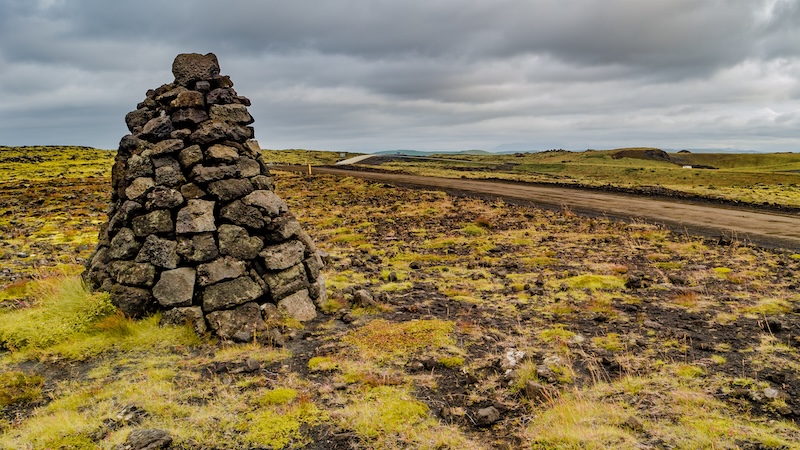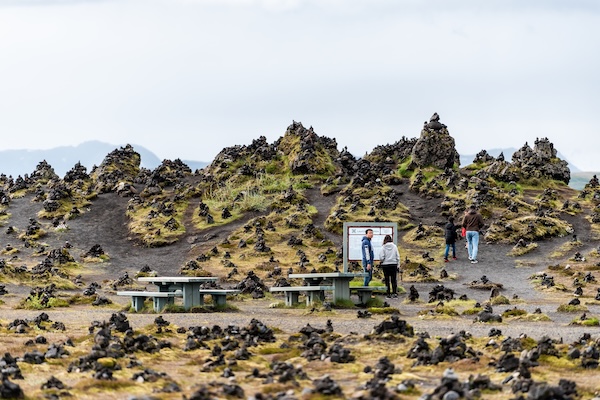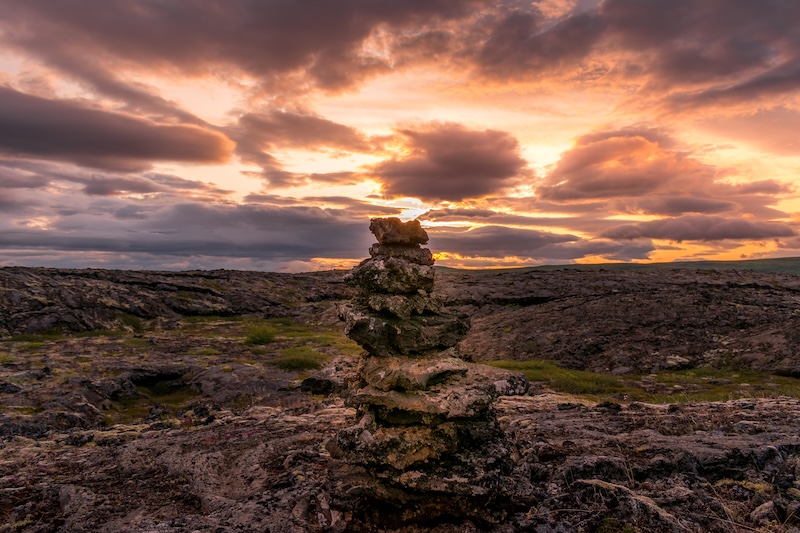Free and exclusive discount codes for hundreds of tours and & travel services in Iceland
Subscribe to instantly receive discount codes for tours, car rental, camper van rental, and outdoor clothing rental. Thank you! ❤️ Jon Heidar, Editor of Stuck in Iceland Travel MagazineYou’re standing at a dramatic Icelandic viewpoint, inspired by the wild beauty around you. Maybe you feel tempted to stack a few stones—a small act of presence, a quiet “I was here.” But here’s the thing: stacking rocks in Iceland is not cool—it’s harmful, confusing, and culturally inappropriate. At first glance, it might seem harmless. But those neat little stone piles popping up all over Iceland’s landscapes are not part of a charming Icelandic tradition—they’re modern intrusions that damage the environment and misrepresent Icelandic heritage. In other words, we really don’t want travelers to build new cairns in Iceland.
Let’s talk about why this is a problem, and then we’ll introduce you to the cairns that actually matter—the ancient ones that have guided people across Iceland for more than a thousand years.

Why Stacking Rocks Is a Real Problem in Iceland
As Iceland becomes a bucket-list destination, the country has seen a rise in visitors stacking stones wherever they go, from mossy lava fields to city parks. What many travelers don’t realize is that this damages fragile ecosystems, confuses hikers, and disrespects Iceland’s heritage.
Local guide Hildur Þöll Ágústsdóttir, interviewed recently by the Icelandic news site Vísir, put it simply:
“This is not art, and it’s not a cultural gesture. It’s just disruption. It damages landscapes that have taken centuries to form.”
In moss-covered lava fields—where moss can take over 100 years to grow—a single misplaced stone leaves a scar that could last for generations. Cairn-building in unauthorized places can also lead hikers off trails, which in Iceland’s often-foggy and treacherous terrain, is downright dangerous.
Iceland is not a theme park. It’s a living, breathing landscape, shaped by ice, fire, changeable weather, and time.
What are cairns in Iceland really meant for?
Stone cairns (vörður in Icelandic) have a long and sacred role in Iceland’s history. Since the age of settlement, Icelandic people would build cairns as navigation tools, trail markers, and sometimes as memorials or spiritual symbols. Some are over a thousand years old.
They weren’t built randomly. And they definitely weren’t built for selfies.
The Cairns That Matter: Iceland’s Historic Rock Markers
Instead of building new cairns, we invite you to admire the real ones—the ones that have stood for centuries, each with a story etched in stone. Here’s a selection of authentic Icelandic cairns and burial mounds worth respecting, visiting, and learning from.

Laufskálavarða – South Iceland
Laufskálavarða is a field of ancient stone cairns near Mýrdalssandur. Traditionally, travelers placed one stone here for good luck before crossing the dangerous black sands. It’s one of the few places where this custom was practiced—and even here, only one stone was added.
Þorskafjarðarheiði Cairns – Westfjords
Large and small cairns along Route 608. Each traveler in old times was expected to erect a small cairn the first time they crossed, for protection and safe passage.
Látraheiði Heath – Westfjords
This area is full of ancient cairns built for protection against fog and danger near cliffs. Travelers were encouraged to stack three small stones when passing for the first time—a symbolic act of safety and guidance.
Dettifoss Route Cairns North Iceland
Mid-19th-century cairns marking the historic trail from Mývatn to Vopnafjörður. These are part of a broader network of ancient routes still visible across the Icelandic wilderness.
Hjörleifshaugur Burial Mound – South Iceland
A cairn-topped burial mound of Hjörleifur, Iceland’s second settler. Built atop Hjörleifshöfði (which also has the ‘Yoda Cave‘), it honors a life cut short by betrayal and marks one of the oldest graves in the country.
Þorgeirsdys – North Iceland
Þorgeirsdys is said to be the burial mound of Viking warrior Þorgeir Hávarsson, who, according to saga legend, killed 14 enemies before being slain himself. His head was buried in Eyjafjörður—but the body is said to rest here.
Völvuleiðið – East Iceland
The burial mound of a prophetess, said to protect the fjord from pirate attacks. Located between Reyðarfjörður and Eskifjörður, it’s a site wrapped in folklore and power.
Grettisvarða – Westfjords
Legend claims that Grettisvarða was built by the outlaw Grettir the Strong, with stones so large that only someone of great strength—or legend—could’ve managed it.
Djáknadys – East Iceland
Also known as the Deacon’s Burial Mound, located in Hamarsfjörður. Tradition says travelers should throw a stone onto the mound to avoid losing their way.
Egils Saga Cairns – West Iceland
Nine cairns are placed across the Borgarfjörður region, marking key events from Egill Skallagrímsson’s Saga. These modern memorials pay tribute to Iceland’s literary and settlement history.
Kleifabúi – Westfjords
A giant stone man on Kleifaheiði heath, built by road workers in 1947. More statue than cairn, but a great example of Icelanders blending stonework, labor, and humor.
And Then There Are the “Bone Crones”…
Some cairns had more playful—even bawdy—purposes. Travelers would leave poems or jokes in hollow bones placed in the cairns for the next person to read. Known as “beinakerling” or Bone crones, they were a kind of traveler’s message board—proof that even Icelanders of yore had a cheeky side.
What You Can Do: Respect, Don’t Stack
Here’s how to be a thoughtful, responsible traveler in Iceland:
- Don’t build stone stacks anywhere, ever, unless clearly marked as permitted
- Admire historic cairns, but don’t add to them or disturb them.
- Stick to marked trails—and don’t follow random cairns off-path.
- Learn the stories behind the places you visit. Iceland is full of them.
- Take only photos, leave only footprints—and memories.
Want to Discover Iceland’s Real Stories?
Get deeper travel tips, authentic Icelandic experiences, and exclusive discounts on responsible tours by subscribing to my Stuck in Iceland Travel Newsletter.
I share:
- Local insights from Icelandic guides
- Hidden gems far from the crowds
- Travel advice that respects the land
- Updates on new features and cultural events
Iceland’s nature doesn’t need your mark—only your care. Let’s keep it wild, storied, and unspoiled.




